Social Determinants of Coronary Heart Disease in Australia Analysis
VerifiedAdded on 2023/04/07
|8
|1194
|377
Essay
AI Summary
This paper examines coronary heart disease (CHD) in Australia, highlighting its prevalence and the significant role of social determinants. It introduces CHD as a major health concern, particularly focusing on coronary heart disease. The paper explores the impact of physical environment, socioeconomic status, employment, and working conditions on CHD prevalence, especially among indigenous populations. The analysis reveals that limited access to healthcare, low socioeconomic status, and poor working environments contribute to increased risk. The paper emphasizes the need for government intervention to address these social determinants to improve health outcomes and reduce the burden of CHD in Australia. The study uses various sources to support its claims.
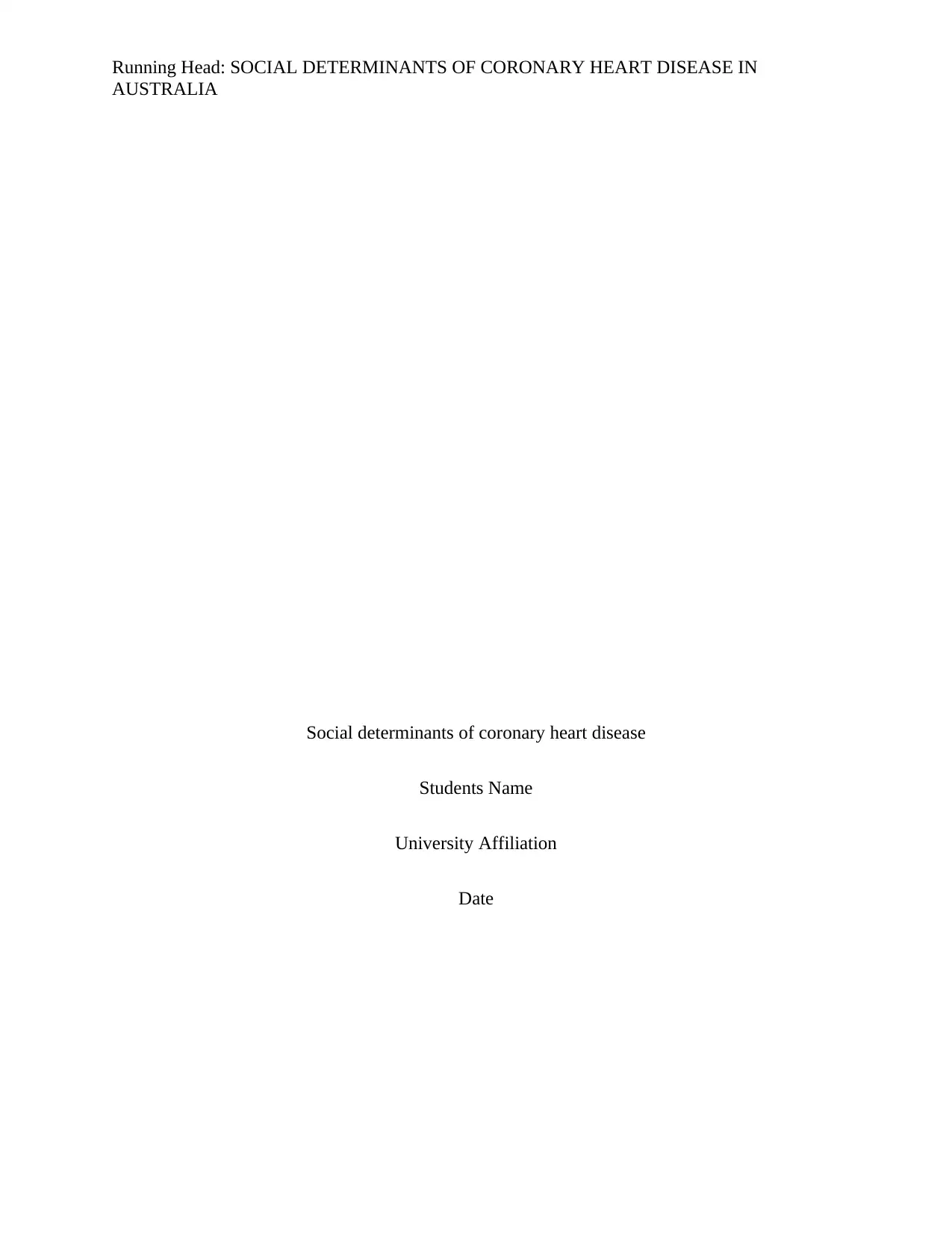
Running Head: SOCIAL DETERMINANTS OF CORONARY HEART DISEASE IN
AUSTRALIA
Social determinants of coronary heart disease
Students Name
University Affiliation
Date
AUSTRALIA
Social determinants of coronary heart disease
Students Name
University Affiliation
Date
Paraphrase This Document
Need a fresh take? Get an instant paraphrase of this document with our AI Paraphraser
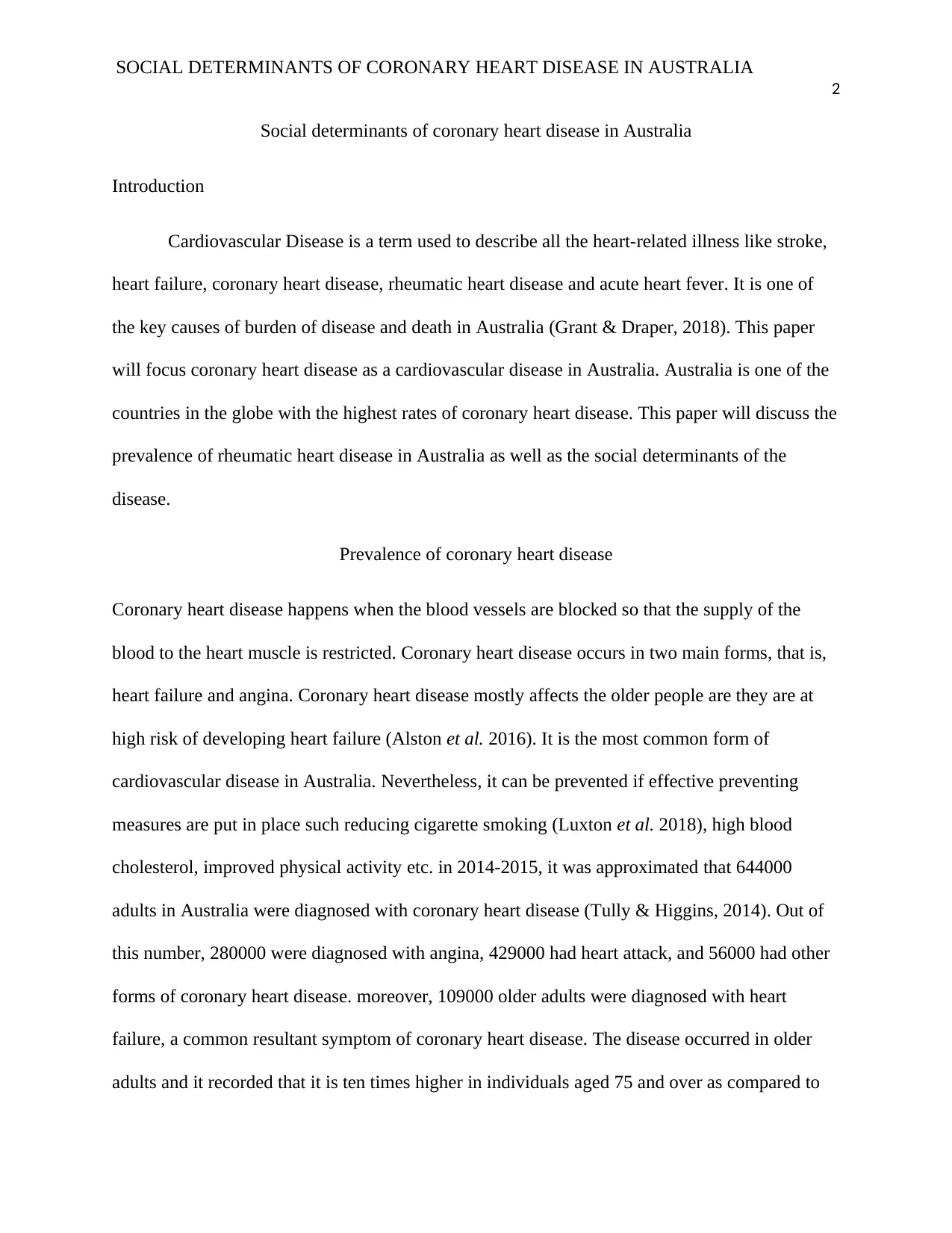
SOCIAL DETERMINANTS OF CORONARY HEART DISEASE IN AUSTRALIA
2
Social determinants of coronary heart disease in Australia
Introduction
Cardiovascular Disease is a term used to describe all the heart-related illness like stroke,
heart failure, coronary heart disease, rheumatic heart disease and acute heart fever. It is one of
the key causes of burden of disease and death in Australia (Grant & Draper, 2018). This paper
will focus coronary heart disease as a cardiovascular disease in Australia. Australia is one of the
countries in the globe with the highest rates of coronary heart disease. This paper will discuss the
prevalence of rheumatic heart disease in Australia as well as the social determinants of the
disease.
Prevalence of coronary heart disease
Coronary heart disease happens when the blood vessels are blocked so that the supply of the
blood to the heart muscle is restricted. Coronary heart disease occurs in two main forms, that is,
heart failure and angina. Coronary heart disease mostly affects the older people are they are at
high risk of developing heart failure (Alston et al. 2016). It is the most common form of
cardiovascular disease in Australia. Nevertheless, it can be prevented if effective preventing
measures are put in place such reducing cigarette smoking (Luxton et al. 2018), high blood
cholesterol, improved physical activity etc. in 2014-2015, it was approximated that 644000
adults in Australia were diagnosed with coronary heart disease (Tully & Higgins, 2014). Out of
this number, 280000 were diagnosed with angina, 429000 had heart attack, and 56000 had other
forms of coronary heart disease. moreover, 109000 older adults were diagnosed with heart
failure, a common resultant symptom of coronary heart disease. The disease occurred in older
adults and it recorded that it is ten times higher in individuals aged 75 and over as compared to
2
Social determinants of coronary heart disease in Australia
Introduction
Cardiovascular Disease is a term used to describe all the heart-related illness like stroke,
heart failure, coronary heart disease, rheumatic heart disease and acute heart fever. It is one of
the key causes of burden of disease and death in Australia (Grant & Draper, 2018). This paper
will focus coronary heart disease as a cardiovascular disease in Australia. Australia is one of the
countries in the globe with the highest rates of coronary heart disease. This paper will discuss the
prevalence of rheumatic heart disease in Australia as well as the social determinants of the
disease.
Prevalence of coronary heart disease
Coronary heart disease happens when the blood vessels are blocked so that the supply of the
blood to the heart muscle is restricted. Coronary heart disease occurs in two main forms, that is,
heart failure and angina. Coronary heart disease mostly affects the older people are they are at
high risk of developing heart failure (Alston et al. 2016). It is the most common form of
cardiovascular disease in Australia. Nevertheless, it can be prevented if effective preventing
measures are put in place such reducing cigarette smoking (Luxton et al. 2018), high blood
cholesterol, improved physical activity etc. in 2014-2015, it was approximated that 644000
adults in Australia were diagnosed with coronary heart disease (Tully & Higgins, 2014). Out of
this number, 280000 were diagnosed with angina, 429000 had heart attack, and 56000 had other
forms of coronary heart disease. moreover, 109000 older adults were diagnosed with heart
failure, a common resultant symptom of coronary heart disease. The disease occurred in older
adults and it recorded that it is ten times higher in individuals aged 75 and over as compared to
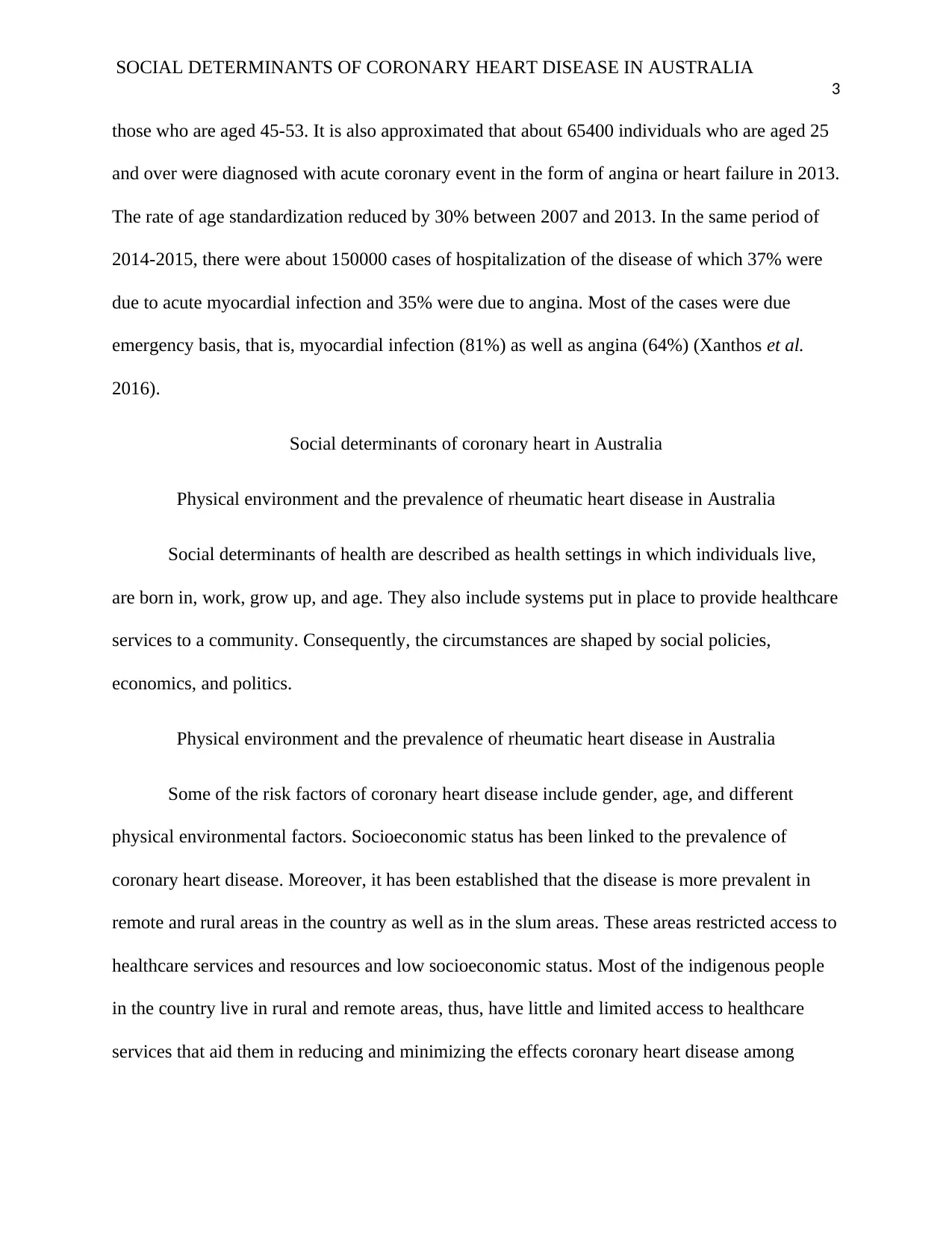
SOCIAL DETERMINANTS OF CORONARY HEART DISEASE IN AUSTRALIA
3
those who are aged 45-53. It is also approximated that about 65400 individuals who are aged 25
and over were diagnosed with acute coronary event in the form of angina or heart failure in 2013.
The rate of age standardization reduced by 30% between 2007 and 2013. In the same period of
2014-2015, there were about 150000 cases of hospitalization of the disease of which 37% were
due to acute myocardial infection and 35% were due to angina. Most of the cases were due
emergency basis, that is, myocardial infection (81%) as well as angina (64%) (Xanthos et al.
2016).
Social determinants of coronary heart in Australia
Physical environment and the prevalence of rheumatic heart disease in Australia
Social determinants of health are described as health settings in which individuals live,
are born in, work, grow up, and age. They also include systems put in place to provide healthcare
services to a community. Consequently, the circumstances are shaped by social policies,
economics, and politics.
Physical environment and the prevalence of rheumatic heart disease in Australia
Some of the risk factors of coronary heart disease include gender, age, and different
physical environmental factors. Socioeconomic status has been linked to the prevalence of
coronary heart disease. Moreover, it has been established that the disease is more prevalent in
remote and rural areas in the country as well as in the slum areas. These areas restricted access to
healthcare services and resources and low socioeconomic status. Most of the indigenous people
in the country live in rural and remote areas, thus, have little and limited access to healthcare
services that aid them in reducing and minimizing the effects coronary heart disease among
3
those who are aged 45-53. It is also approximated that about 65400 individuals who are aged 25
and over were diagnosed with acute coronary event in the form of angina or heart failure in 2013.
The rate of age standardization reduced by 30% between 2007 and 2013. In the same period of
2014-2015, there were about 150000 cases of hospitalization of the disease of which 37% were
due to acute myocardial infection and 35% were due to angina. Most of the cases were due
emergency basis, that is, myocardial infection (81%) as well as angina (64%) (Xanthos et al.
2016).
Social determinants of coronary heart in Australia
Physical environment and the prevalence of rheumatic heart disease in Australia
Social determinants of health are described as health settings in which individuals live,
are born in, work, grow up, and age. They also include systems put in place to provide healthcare
services to a community. Consequently, the circumstances are shaped by social policies,
economics, and politics.
Physical environment and the prevalence of rheumatic heart disease in Australia
Some of the risk factors of coronary heart disease include gender, age, and different
physical environmental factors. Socioeconomic status has been linked to the prevalence of
coronary heart disease. Moreover, it has been established that the disease is more prevalent in
remote and rural areas in the country as well as in the slum areas. These areas restricted access to
healthcare services and resources and low socioeconomic status. Most of the indigenous people
in the country live in rural and remote areas, thus, have little and limited access to healthcare
services that aid them in reducing and minimizing the effects coronary heart disease among
⊘ This is a preview!⊘
Do you want full access?
Subscribe today to unlock all pages.

Trusted by 1+ million students worldwide
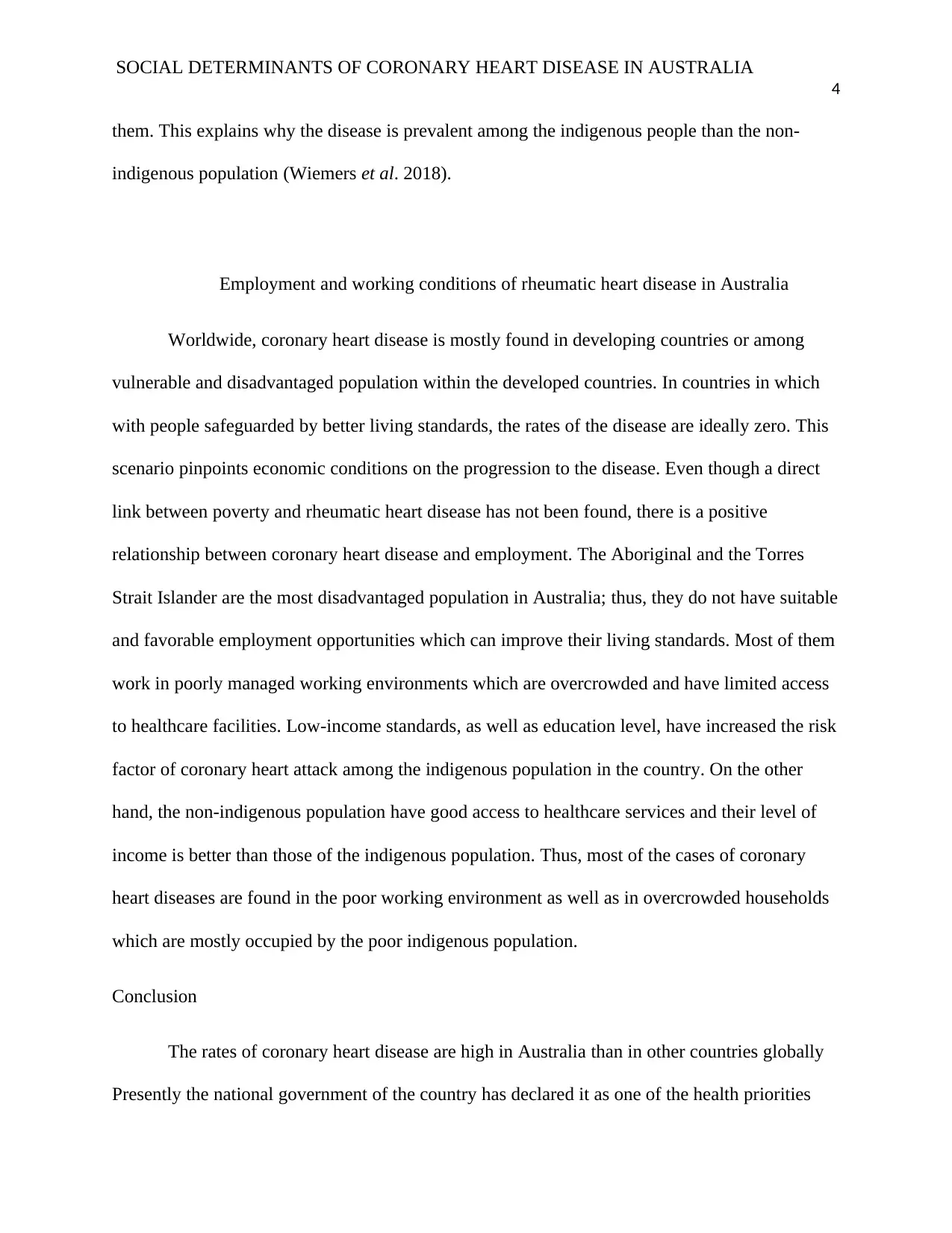
SOCIAL DETERMINANTS OF CORONARY HEART DISEASE IN AUSTRALIA
4
them. This explains why the disease is prevalent among the indigenous people than the non-
indigenous population (Wiemers et al. 2018).
Employment and working conditions of rheumatic heart disease in Australia
Worldwide, coronary heart disease is mostly found in developing countries or among
vulnerable and disadvantaged population within the developed countries. In countries in which
with people safeguarded by better living standards, the rates of the disease are ideally zero. This
scenario pinpoints economic conditions on the progression to the disease. Even though a direct
link between poverty and rheumatic heart disease has not been found, there is a positive
relationship between coronary heart disease and employment. The Aboriginal and the Torres
Strait Islander are the most disadvantaged population in Australia; thus, they do not have suitable
and favorable employment opportunities which can improve their living standards. Most of them
work in poorly managed working environments which are overcrowded and have limited access
to healthcare facilities. Low-income standards, as well as education level, have increased the risk
factor of coronary heart attack among the indigenous population in the country. On the other
hand, the non-indigenous population have good access to healthcare services and their level of
income is better than those of the indigenous population. Thus, most of the cases of coronary
heart diseases are found in the poor working environment as well as in overcrowded households
which are mostly occupied by the poor indigenous population.
Conclusion
The rates of coronary heart disease are high in Australia than in other countries globally
Presently the national government of the country has declared it as one of the health priorities
4
them. This explains why the disease is prevalent among the indigenous people than the non-
indigenous population (Wiemers et al. 2018).
Employment and working conditions of rheumatic heart disease in Australia
Worldwide, coronary heart disease is mostly found in developing countries or among
vulnerable and disadvantaged population within the developed countries. In countries in which
with people safeguarded by better living standards, the rates of the disease are ideally zero. This
scenario pinpoints economic conditions on the progression to the disease. Even though a direct
link between poverty and rheumatic heart disease has not been found, there is a positive
relationship between coronary heart disease and employment. The Aboriginal and the Torres
Strait Islander are the most disadvantaged population in Australia; thus, they do not have suitable
and favorable employment opportunities which can improve their living standards. Most of them
work in poorly managed working environments which are overcrowded and have limited access
to healthcare facilities. Low-income standards, as well as education level, have increased the risk
factor of coronary heart attack among the indigenous population in the country. On the other
hand, the non-indigenous population have good access to healthcare services and their level of
income is better than those of the indigenous population. Thus, most of the cases of coronary
heart diseases are found in the poor working environment as well as in overcrowded households
which are mostly occupied by the poor indigenous population.
Conclusion
The rates of coronary heart disease are high in Australia than in other countries globally
Presently the national government of the country has declared it as one of the health priorities
Paraphrase This Document
Need a fresh take? Get an instant paraphrase of this document with our AI Paraphraser
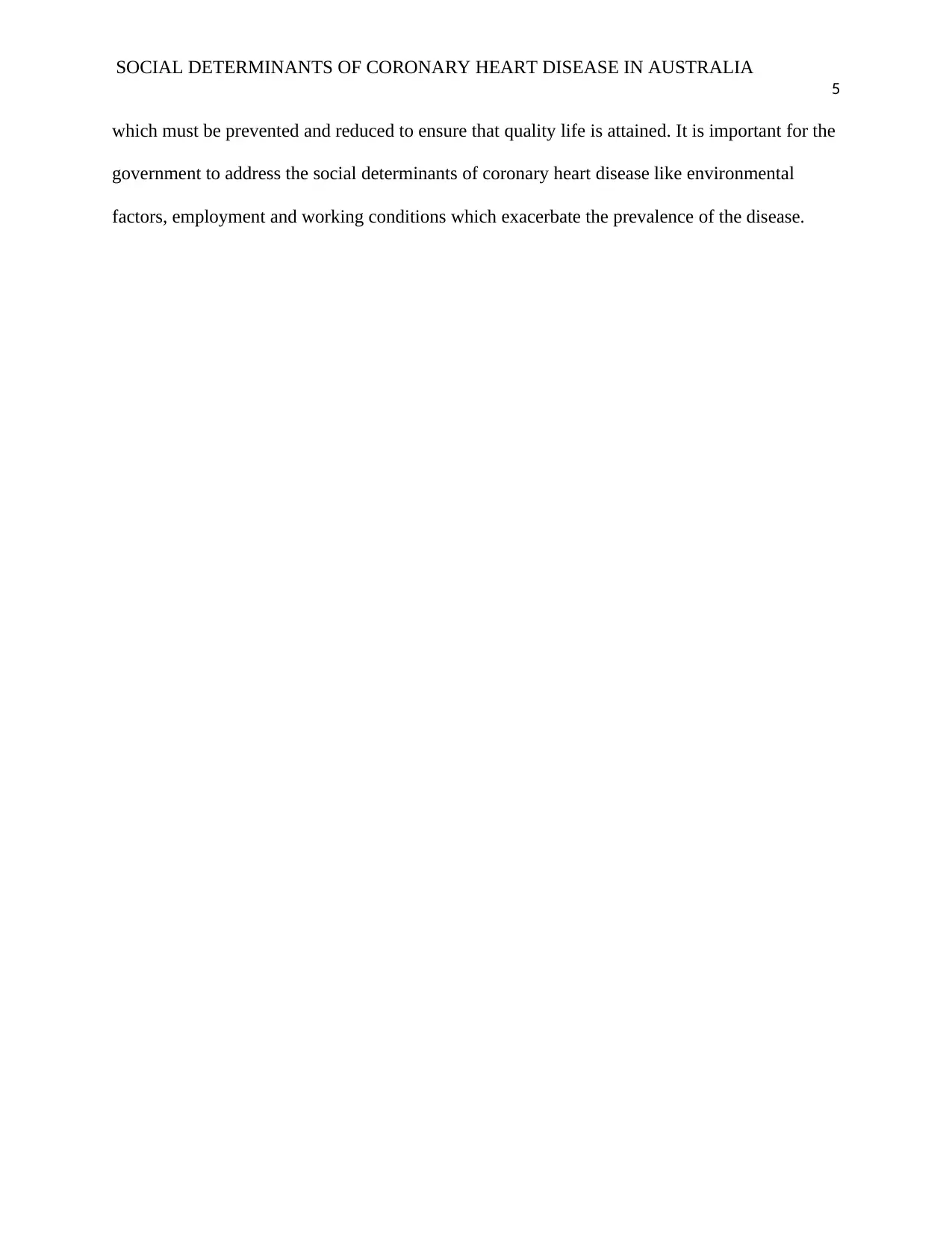
SOCIAL DETERMINANTS OF CORONARY HEART DISEASE IN AUSTRALIA
5
which must be prevented and reduced to ensure that quality life is attained. It is important for the
government to address the social determinants of coronary heart disease like environmental
factors, employment and working conditions which exacerbate the prevalence of the disease.
5
which must be prevented and reduced to ensure that quality life is attained. It is important for the
government to address the social determinants of coronary heart disease like environmental
factors, employment and working conditions which exacerbate the prevalence of the disease.
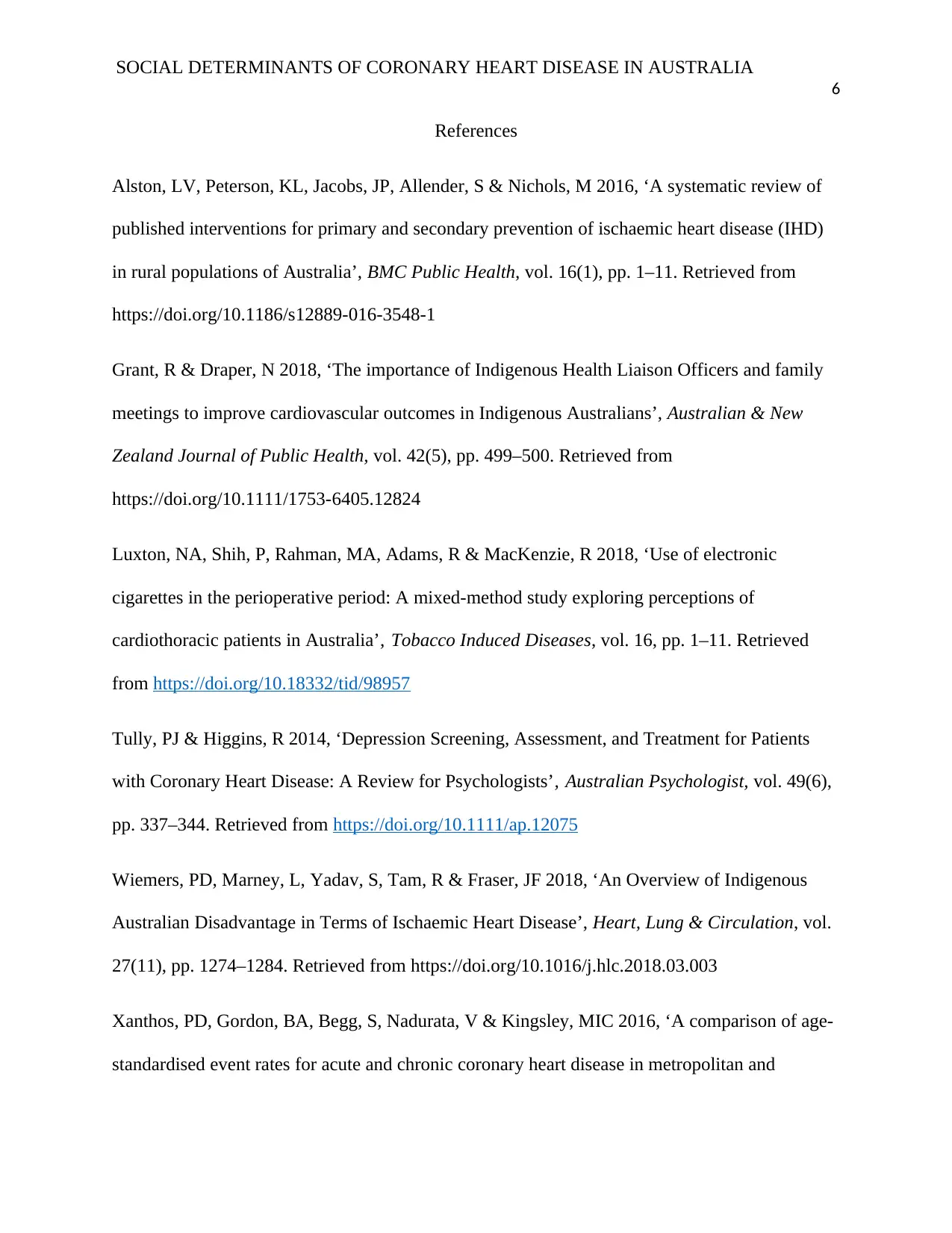
SOCIAL DETERMINANTS OF CORONARY HEART DISEASE IN AUSTRALIA
6
References
Alston, LV, Peterson, KL, Jacobs, JP, Allender, S & Nichols, M 2016, ‘A systematic review of
published interventions for primary and secondary prevention of ischaemic heart disease (IHD)
in rural populations of Australia’, BMC Public Health, vol. 16(1), pp. 1–11. Retrieved from
https://doi.org/10.1186/s12889-016-3548-1
Grant, R & Draper, N 2018, ‘The importance of Indigenous Health Liaison Officers and family
meetings to improve cardiovascular outcomes in Indigenous Australians’, Australian & New
Zealand Journal of Public Health, vol. 42(5), pp. 499–500. Retrieved from
https://doi.org/10.1111/1753-6405.12824
Luxton, NA, Shih, P, Rahman, MA, Adams, R & MacKenzie, R 2018, ‘Use of electronic
cigarettes in the perioperative period: A mixed-method study exploring perceptions of
cardiothoracic patients in Australia’, Tobacco Induced Diseases, vol. 16, pp. 1–11. Retrieved
from https://doi.org/10.18332/tid/98957
Tully, PJ & Higgins, R 2014, ‘Depression Screening, Assessment, and Treatment for Patients
with Coronary Heart Disease: A Review for Psychologists’, Australian Psychologist, vol. 49(6),
pp. 337–344. Retrieved from https://doi.org/10.1111/ap.12075
Wiemers, PD, Marney, L, Yadav, S, Tam, R & Fraser, JF 2018, ‘An Overview of Indigenous
Australian Disadvantage in Terms of Ischaemic Heart Disease’, Heart, Lung & Circulation, vol.
27(11), pp. 1274–1284. Retrieved from https://doi.org/10.1016/j.hlc.2018.03.003
Xanthos, PD, Gordon, BA, Begg, S, Nadurata, V & Kingsley, MIC 2016, ‘A comparison of age-
standardised event rates for acute and chronic coronary heart disease in metropolitan and
6
References
Alston, LV, Peterson, KL, Jacobs, JP, Allender, S & Nichols, M 2016, ‘A systematic review of
published interventions for primary and secondary prevention of ischaemic heart disease (IHD)
in rural populations of Australia’, BMC Public Health, vol. 16(1), pp. 1–11. Retrieved from
https://doi.org/10.1186/s12889-016-3548-1
Grant, R & Draper, N 2018, ‘The importance of Indigenous Health Liaison Officers and family
meetings to improve cardiovascular outcomes in Indigenous Australians’, Australian & New
Zealand Journal of Public Health, vol. 42(5), pp. 499–500. Retrieved from
https://doi.org/10.1111/1753-6405.12824
Luxton, NA, Shih, P, Rahman, MA, Adams, R & MacKenzie, R 2018, ‘Use of electronic
cigarettes in the perioperative period: A mixed-method study exploring perceptions of
cardiothoracic patients in Australia’, Tobacco Induced Diseases, vol. 16, pp. 1–11. Retrieved
from https://doi.org/10.18332/tid/98957
Tully, PJ & Higgins, R 2014, ‘Depression Screening, Assessment, and Treatment for Patients
with Coronary Heart Disease: A Review for Psychologists’, Australian Psychologist, vol. 49(6),
pp. 337–344. Retrieved from https://doi.org/10.1111/ap.12075
Wiemers, PD, Marney, L, Yadav, S, Tam, R & Fraser, JF 2018, ‘An Overview of Indigenous
Australian Disadvantage in Terms of Ischaemic Heart Disease’, Heart, Lung & Circulation, vol.
27(11), pp. 1274–1284. Retrieved from https://doi.org/10.1016/j.hlc.2018.03.003
Xanthos, PD, Gordon, BA, Begg, S, Nadurata, V & Kingsley, MIC 2016, ‘A comparison of age-
standardised event rates for acute and chronic coronary heart disease in metropolitan and
⊘ This is a preview!⊘
Do you want full access?
Subscribe today to unlock all pages.

Trusted by 1+ million students worldwide
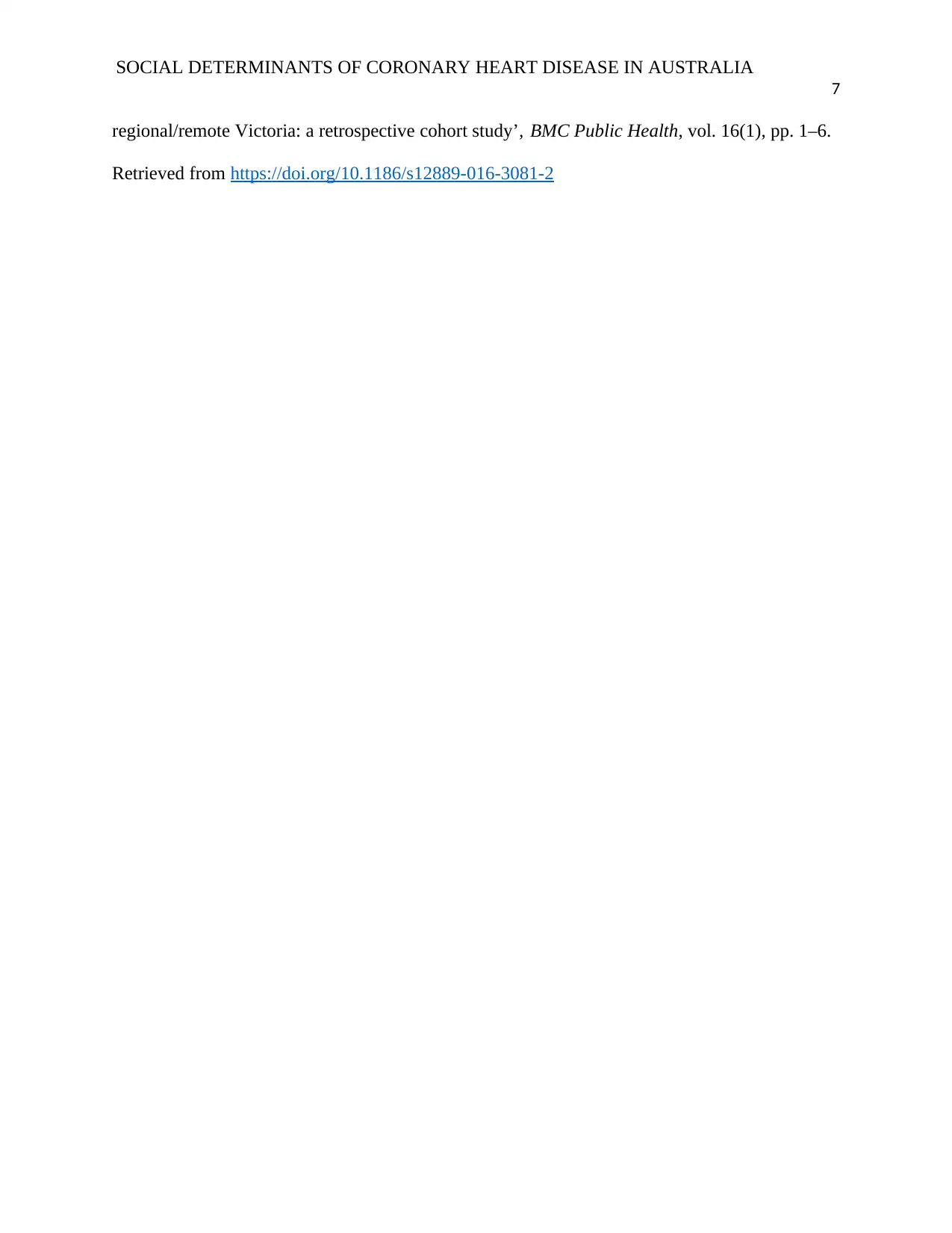
SOCIAL DETERMINANTS OF CORONARY HEART DISEASE IN AUSTRALIA
7
regional/remote Victoria: a retrospective cohort study’, BMC Public Health, vol. 16(1), pp. 1–6.
Retrieved from https://doi.org/10.1186/s12889-016-3081-2
7
regional/remote Victoria: a retrospective cohort study’, BMC Public Health, vol. 16(1), pp. 1–6.
Retrieved from https://doi.org/10.1186/s12889-016-3081-2
Paraphrase This Document
Need a fresh take? Get an instant paraphrase of this document with our AI Paraphraser
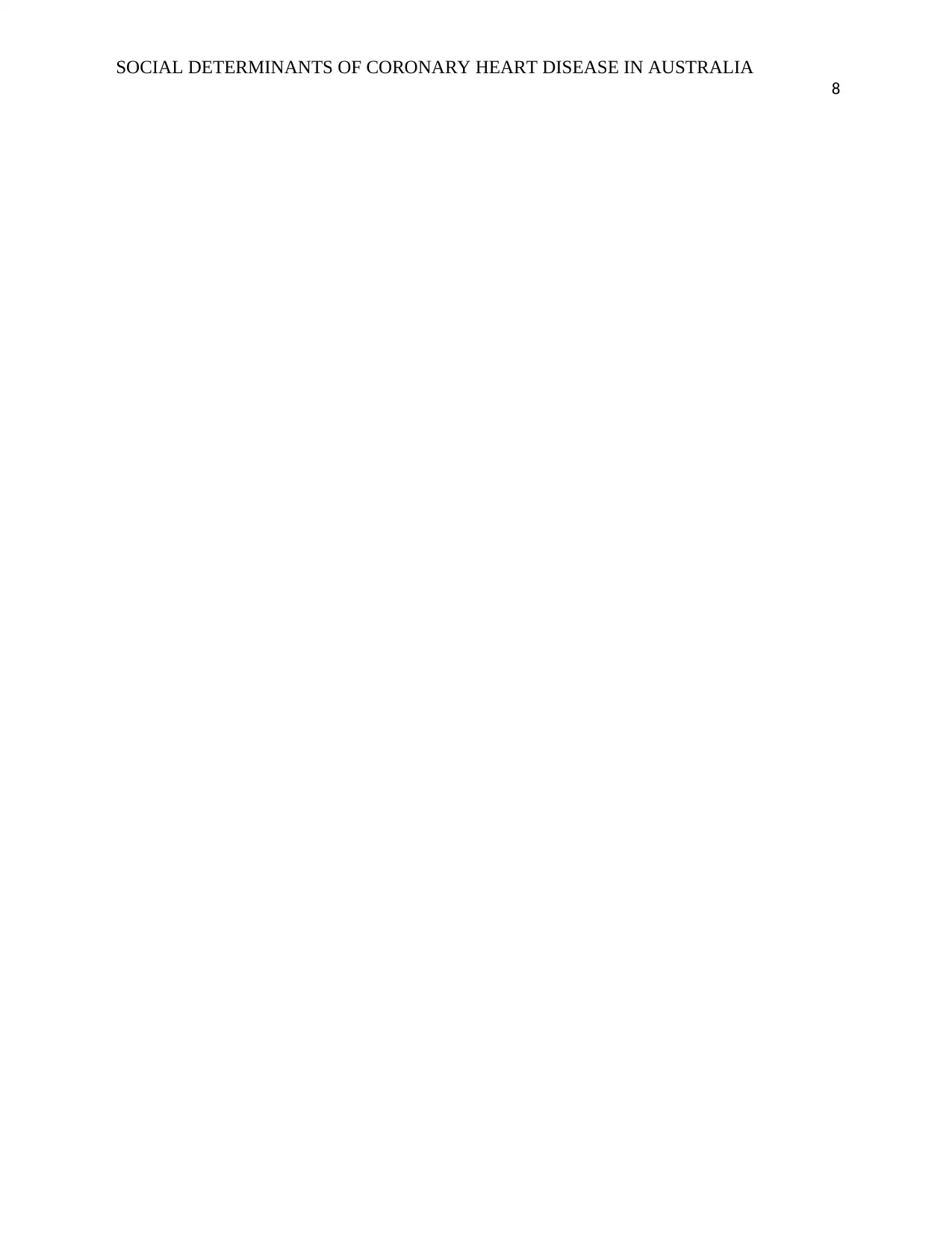
SOCIAL DETERMINANTS OF CORONARY HEART DISEASE IN AUSTRALIA
8
8
1 out of 8
Related Documents
Your All-in-One AI-Powered Toolkit for Academic Success.
+13062052269
info@desklib.com
Available 24*7 on WhatsApp / Email
![[object Object]](/_next/static/media/star-bottom.7253800d.svg)
Unlock your academic potential
Copyright © 2020–2025 A2Z Services. All Rights Reserved. Developed and managed by ZUCOL.





